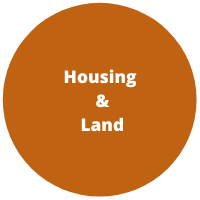The Honduran national government is building a thoroughfare called “The Capital ByPass”. Its construction required, in its first stage, the eviction of 2000 families, primarily from poor neighbourhoods. One of the most affected neighbourhoods is Colonia Villanueva, from which 600 families were to be displaced. These families squatted on a lot next to the land where they had formerly lived, and were violently removed two weeks later. As a result of this situation, the Committee of Residents evicted for the Construction of the By-Pass, christened at the time of the squatting, sought support from the Federation in Defense of the Land Occupiers of Honduras (FEDIPTENH). This organization in turn asked the Honduran Association for Community Development (f) to handle the case, since its Board is the same as that of FEDIPTENH.
ADHEC brought together all those who had been affected by the construction of the ByPass to seek their opinion and find joint solutions to the problem.
The displaced residents asserted that they wished to remain on the lot where they had squatted and from which they were evicted. The gave AHDEC power of attorney to negotiate the purchase of the land, to design its urbanization, and to negotiate the steps necessary to resettle the evicted.
AHDEC began to negotiate a just price with the owners of the land, finally agreeing upon, US$3,55 per square “vara”( a square “vara” being equal to 0.64 square meters) on June 15, 1994. The area was approximately 240,000 square varas. However, the project suffered delays in its implementation due to the slowness of governmental decisionmaking regarding the financial mechanism to be adopted, and due to difficulties in finding a private bank which wished to act as a financial intermediary (as required by the governmental housing fund, FOVI).
All the private banks closed their doors to the community, because they were dedicated to financing middle and upper class housing and not housing projects or units for low-income families.
Finally, a private bank, the La Constancia Savings and Loan Association, decided to accept the project with the initial condition that each household would provide 20% of the value of their lot. Upon analyzing this proposal together with the savings and loan, it was discovered that this requirement would raise monthly payments to the equivalent of three times the minimum wage, thus putting them out of the reach of the members of the La Candelaria community.
The rules were thus changed as follows: the project was to be implemented in three stages. Stage 1 involved the purchase of the land; Stage 11, urbanization; Stage III, housing construction. For the first stage, each household had to provide 30% of the value of their land in order to reduce monthly payments. Thus, a typical lot of 206 square “varas” (equal to 143 square meters) without services was valued at US$1631.58 for which a premium or down payment of $489.47 would be due. The difference was to be paid in 24 monthly payments of $47.59, the equivalent of 70% of the minimum monthly wage.
Under these conditions, FOVI approved the financing for the total amount of $605,295,84; the financial intermediary or private bank provided $78,633.60, and the residents, $300,000. That is, FOVI provided 80%; the private bank, 10%; and the residents, 30% for a total of 120%. The 20% excess was used to pay for plans and the design for installment of services necessary to obtain financing, and to ensure that resources would be available with which to make the first advance payment.
On September 12, 1995, title was signed over by the owners of the land to AHDEC, which was in charge of subdividing the land and providing individual titles to each of the 610 households.
While the first stage was still underway, preparations were initiated for the second stage, within a grace period and according to the conditions agreed upon with FOVI. The urbanization stage, which included providing streets, walls, electricity, potable water, sewage and storm sewers, cost a total of $4,813,364.27. The third step involved the construction of the basic housing units, each with an area of 50.2 square meters, with dining room, bedroom, kitchen and bathroom at a cost of $3,184,035.82.


